Effect of the Tumor Suppressor miR-320a on Viability and Functionality of Human Osteosarcoma Cell Lines Compared to Primary Osteoblasts
Abstract
1. Introduction
2. Materials and Methods
2.1. Cell Culture
2.2. Cell Transfection
2.3. miR-320a Quantification by qPCR
2.4. Cell Viability Assay
2.5. Cell Proliferation Quantification
2.6. Osteoblast Mineralization Capacity
2.7. ALP Activity Assay
2.8. Oxidative Stress Evaluation
2.9. Bioinformatic Analyses
2.10. Statistical Analysis
3. Results
3.1. miR-320a Levels Quantification
3.2. Cell Viability and Proliferation
3.3. ALP Activity
3.4. Assessment of Cell Mineralization Capacity
3.5. Cellular Oxidative Stress Measurement
3.6. Pathway Analysis
4. Discussion
Supplementary Materials
Author Contributions
Funding
Conflicts of Interest
References
- Kranjc, T.; Ostanek, B.; Marc, J. Bone microRNAs and Ageing. Curr. Pharm. Biotechnol. 2017, 18, 210–220. [Google Scholar] [CrossRef] [PubMed]
- De-Ugarte, L.; Yoskovitz, G.; Balcells, S.; Guerri-Fernandez, R.; Martinez-Diaz, S.; Mellibovsky, L.; Urreizti, R.; Nogues, X.; Grinberg, D.; Garcia-Giralt, N.; et al. MiRNA profiling of whole trabecular bone: Identification of osteoporosis-related changes in MiRNAs in human hip bones. BMC Med. Genom. 2015, 8, 75. [Google Scholar] [CrossRef]
- Diaz-Prado, S.; Cicione, C.; Muinos-Lopez, E.; Hermida-Gomez, T.; Oreiro, N.; Fernandez-Lopez, C.; Blanco, F.J. Characterization of microRNA expression profiles in normal and osteoarthritic human chondrocytes. BMC Musculoskelet. Disord. 2012, 13, 144. [Google Scholar] [CrossRef] [PubMed]
- Peng, H.; Liang, D.; Li, B.; Liang, C.; Huang, W.; Lin, H. MicroRNA-320a protects against osteoarthritis cartilage degeneration by regulating the expressions of BMI-1 and RUNX2 in chondrocytes. Pharmazie 2017, 72, 223–226. [Google Scholar] [CrossRef] [PubMed]
- Liu, G.Z.; Chen, C.; Kong, N.; Tian, R.; Li, Y.Y.; Li, Z.; Wang, K.Z.; Yang, P. Identification of potential miRNA biomarkers for traumatic osteonecrosis of femoral head. J. Cell Physiol. 2020. [Google Scholar] [CrossRef] [PubMed]
- Lian, F.; Cui, Y.; Zhou, C.; Gao, K.; Wu, L. Identification of a plasma four-microRNA panel as potential noninvasive biomarker for osteosarcoma. PLoS ONE 2015, 10, e0121499. [Google Scholar] [CrossRef]
- Wang, J.; Shi, C.; Wang, J.; Cao, L.; Zhong, L.; Wang, D. MicroRNA-320a is downregulated in non-small cell lung cancer and suppresses tumor cell growth and invasion by directly targeting insulin-like growth factor 1 receptor. Oncol. Lett. 2017, 13, 3247–3252. [Google Scholar] [CrossRef]
- Lu, C.; Liao, Z.; Cai, M.; Zhang, G. MicroRNA-320a downregulation mediates human liver cancer cell proliferation through the Wnt/beta-catenin signaling pathway. Oncol. Lett. 2017, 13, 573–578. [Google Scholar] [CrossRef]
- Cheng, C.; Chen, Z.Q.; Shi, X.T. MicroRNA-320 inhibits osteosarcoma cells proliferation by directly targeting fatty acid synthase. Tumor Biol. 2014. [Google Scholar] [CrossRef]
- Li, C.; Zhang, S.; Qiu, T.; Wang, Y.; Ricketts, D.M.; Qi, C. Upregulation of long non-coding RNA NNT-AS1 promotes osteosarcoma progression by inhibiting the tumor suppressive miR-320a. Cancer Biol. Ther. 2019, 20, 413–422. [Google Scholar] [CrossRef]
- Wang, Y.; Yang, J.; Chen, P.; Song, Y.; An, W.; Zhang, H.; Butegeleqi, B.; Yan, J. MicroRNA-320a inhibits invasion and metastasis in osteosarcoma by targeting cytoplasmic polyadenylation element-binding protein 1. Cancer Med. 2020. [Google Scholar] [CrossRef] [PubMed]
- De-Ugarte, L.; Serra-Vinardell, J.; Nonell, L.; Balcells, S.; Arnal, M.; Nogues, X.; Mellibovsky, L.; Grinberg, D.; Diez-Perez, A.; Garcia-Giralt, N. Expression profiling of microRNAs in human bone tissue from postmenopausal women. Hum. Cell 2017. [Google Scholar] [CrossRef] [PubMed]
- De-Ugarte, L.; Balcells, S.; Nogues, X.; Grinberg, D.; Diez-Perez, A.; Garcia-Giralt, N. Pro-osteoporotic miR-320a impairs osteoblast function and induces oxidative stress. PLoS ONE 2018, 13, e0208131. [Google Scholar] [CrossRef] [PubMed]
- Huang, J.; Meng, Y.; Liu, Y.; Chen, Y.; Yang, H.; Chen, D.; Shi, J.; Guo, Y. MicroRNA-320a Regulates the Osteogenic Differentiation of Human Bone Marrow-Derived Mesenchymal Stem Cells by Targeting HOXA10. Cell Physiol. Biochem. 2016, 38, 40–48. [Google Scholar] [CrossRef] [PubMed]
- Yu, F.; Cui, Y.; Zhou, X.; Zhang, X.; Han, J. Osteogenic differentiation of human ligament fibroblasts induced by conditioned medium of osteoclast-like cells. Biosci. Trends 2011, 5, 46–51. [Google Scholar] [CrossRef] [PubMed]
- Wu, H.; Li, W.; Zhang, M.; Zhu, S.; Zhang, D.; Wang, X. Inhibitory roles of miR-320 in osteosarcoma via regulating E2F1. J. Cancer Res. Ther. 2016, 12, 68–71. [Google Scholar] [CrossRef]
- Vlachos, I.S.; Zagganas, K.; Paraskevopoulou, M.D.; Georgakilas, G.; Karagkouni, D.; Vergoulis, T.; Dalamagas, T.; Hatzigeorgiou, A.G. DIANA-miRPath v3.0: Deciphering microRNA function with experimental support. Nucleic Acids Res. 2015, 43, W460–W466. [Google Scholar] [CrossRef]
- Zhang, T.; Zou, P.; Wang, T.; Xiang, J.; Cheng, J.; Chen, D.; Zhou, J. Down-regulation of miR-320 associated with cancer progression and cell apoptosis via targeting Mcl-1 in cervical cancer. Tumor Biol. 2016, 37, 8931–8940. [Google Scholar] [CrossRef]
- Chen, G.; Deng, C.; Li, Y.P. TGF-beta and BMP signaling in osteoblast differentiation and bone formation. Int. J. Biol. Sci. 2012, 8, 272–288. [Google Scholar] [CrossRef]
- Yang, R.; Piperdi, S.; Zhang, Y.; Zhu, Z.; Neophytou, N.; Hoang, B.H.; Mason, G.; Geller, D.; Dorfman, H.; Meyers, P.A.; et al. Transcriptional Profiling Identifies the Signaling Axes of IGF and Transforming Growth Factor-b as Involved in the Pathogenesis of Osteosarcoma. Clin. Orthop. Relat. Res. 2016, 474, 178–189. [Google Scholar] [CrossRef]
- Domazetovic, V.; Marcucci, G.; Iantomasi, T.; Brandi, M.L.; Vincenzini, M.T. Oxidative stress in bone remodeling: Role of antioxidants. Clin. Cases Miner. Bone Metab. 2017, 14, 209–216. [Google Scholar] [CrossRef] [PubMed]
- Myatt, S.S.; Brosens, J.J.; Lam, E.W. Sense and sensitivity: FOXO and ROS in cancer development and treatment. Antioxid. Redox Signal. 2011, 14, 675–687. [Google Scholar] [CrossRef] [PubMed]
- Liou, G.Y.; Storz, P. Reactive oxygen species in cancer. Free Radic. Res. 2010, 44, 479–496. [Google Scholar] [CrossRef] [PubMed]
- Liu, J.; Wang, Z. Increased Oxidative Stress as a Selective Anticancer Therapy. Oxid. Med. Cell. Longev. 2015, 2015, 294303. [Google Scholar] [CrossRef]
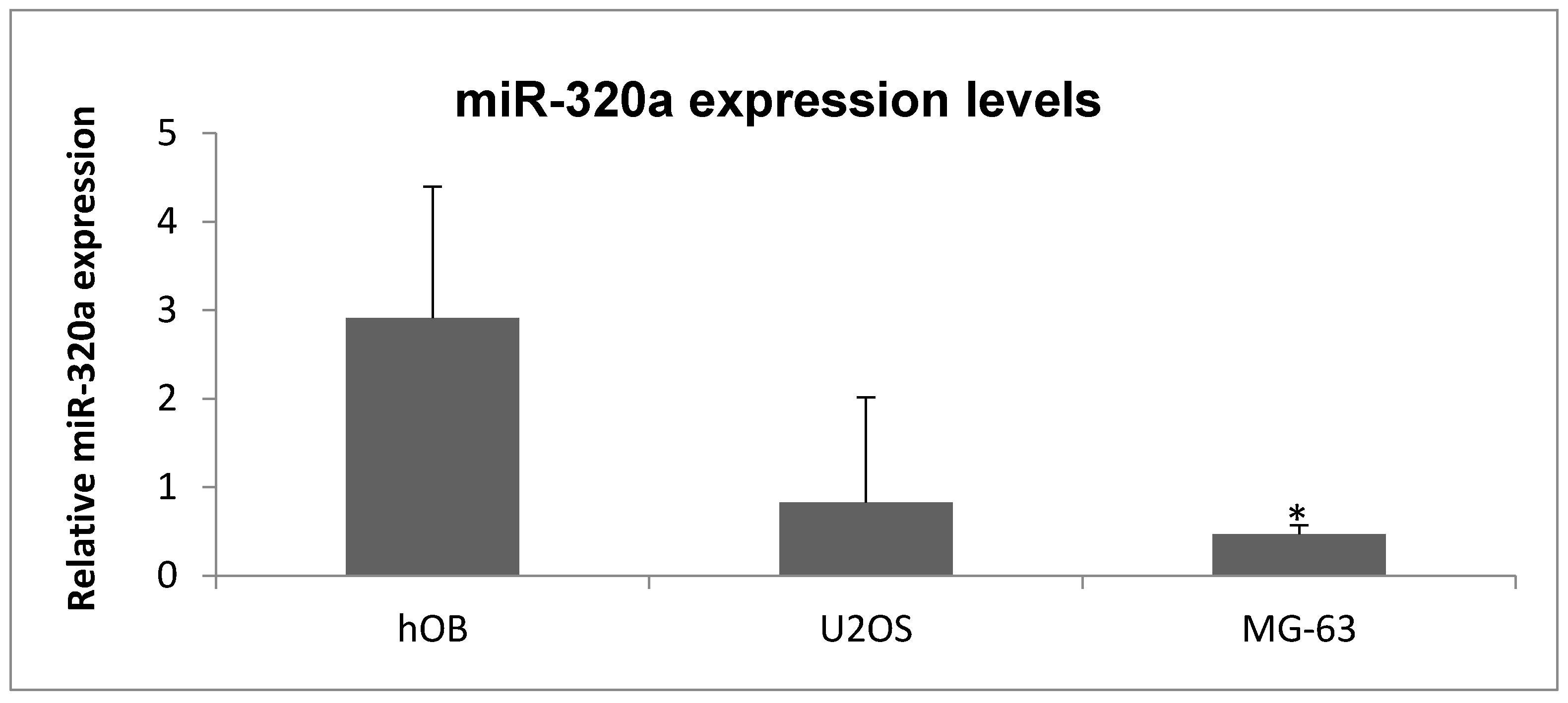
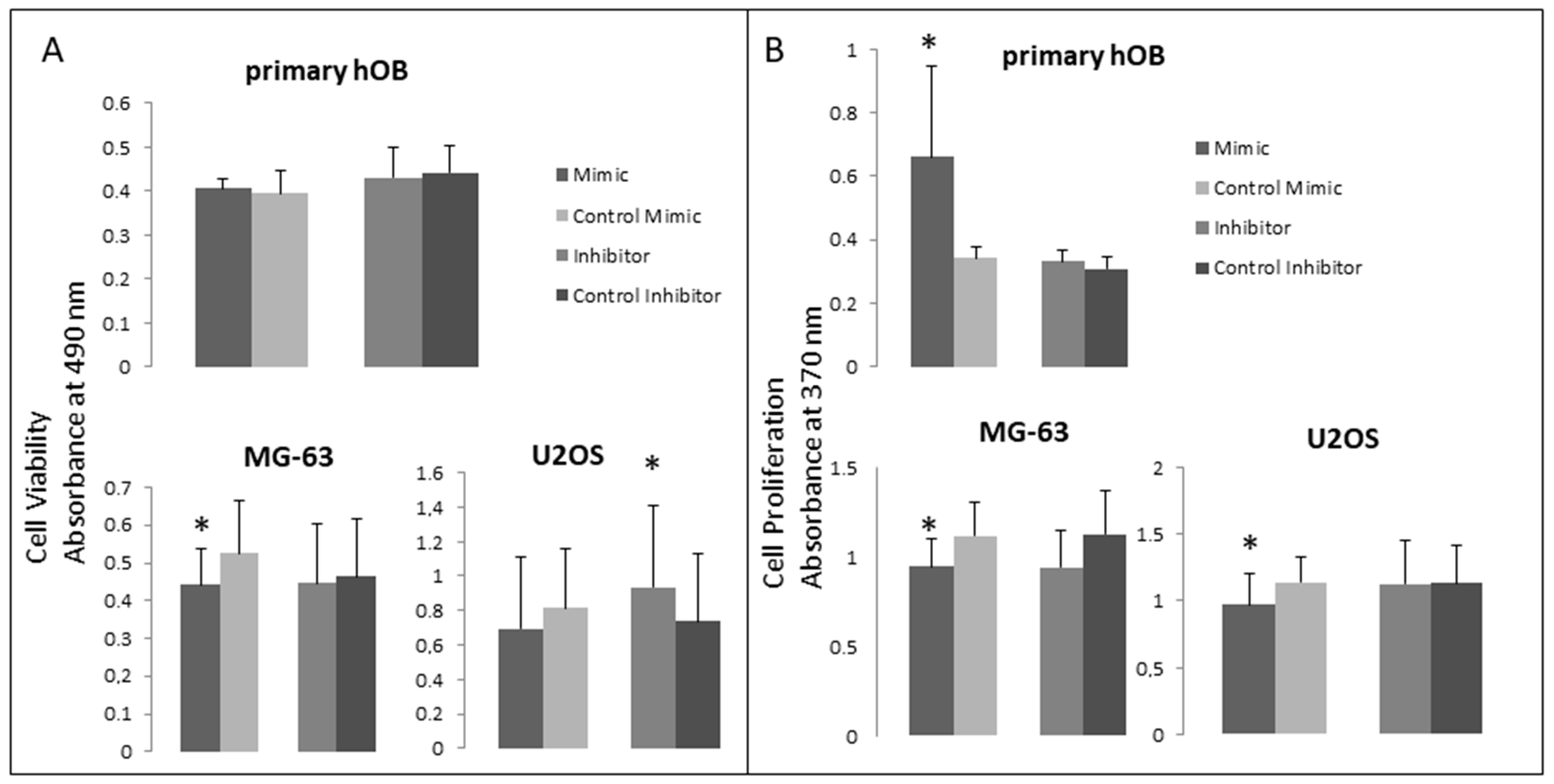
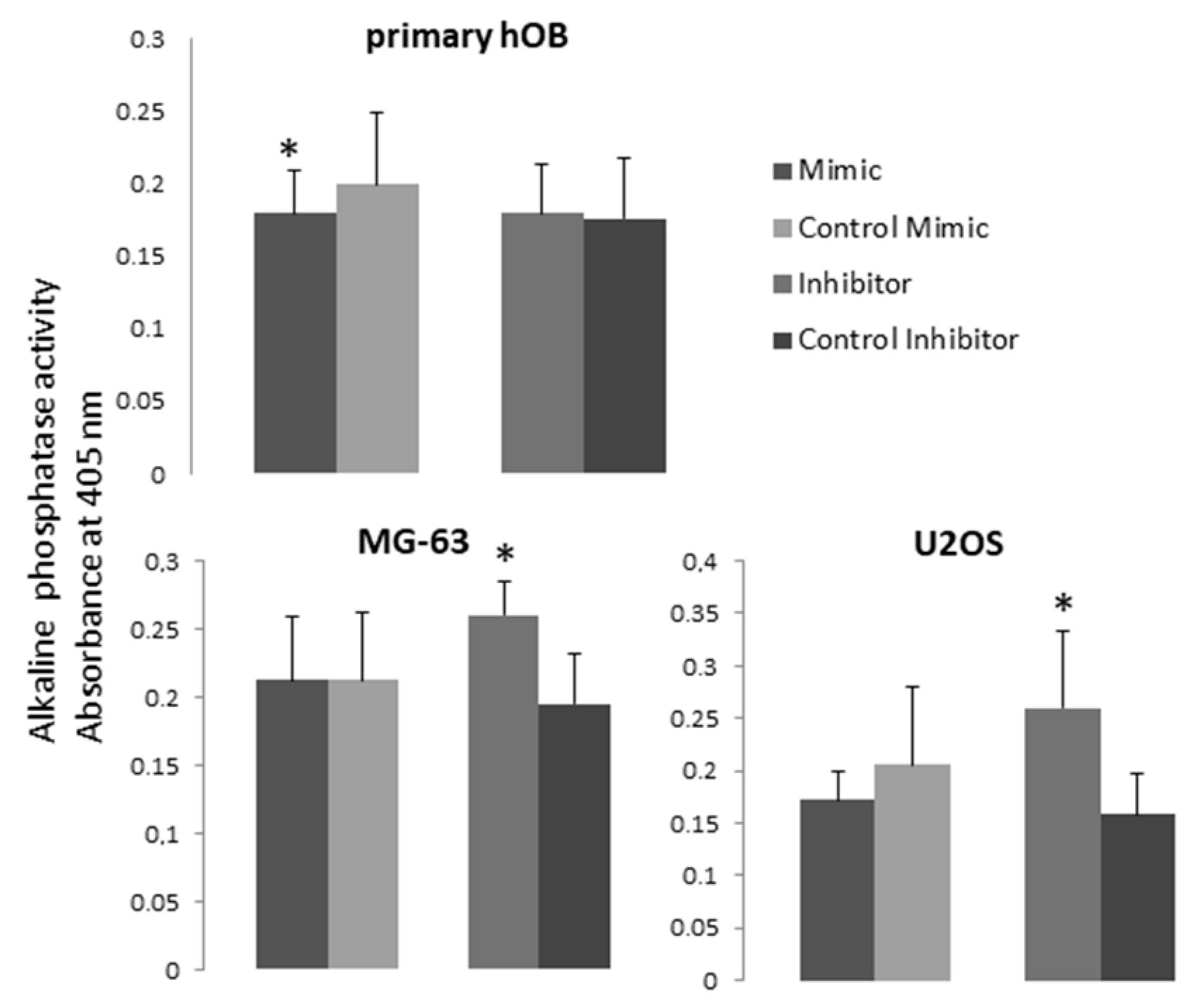
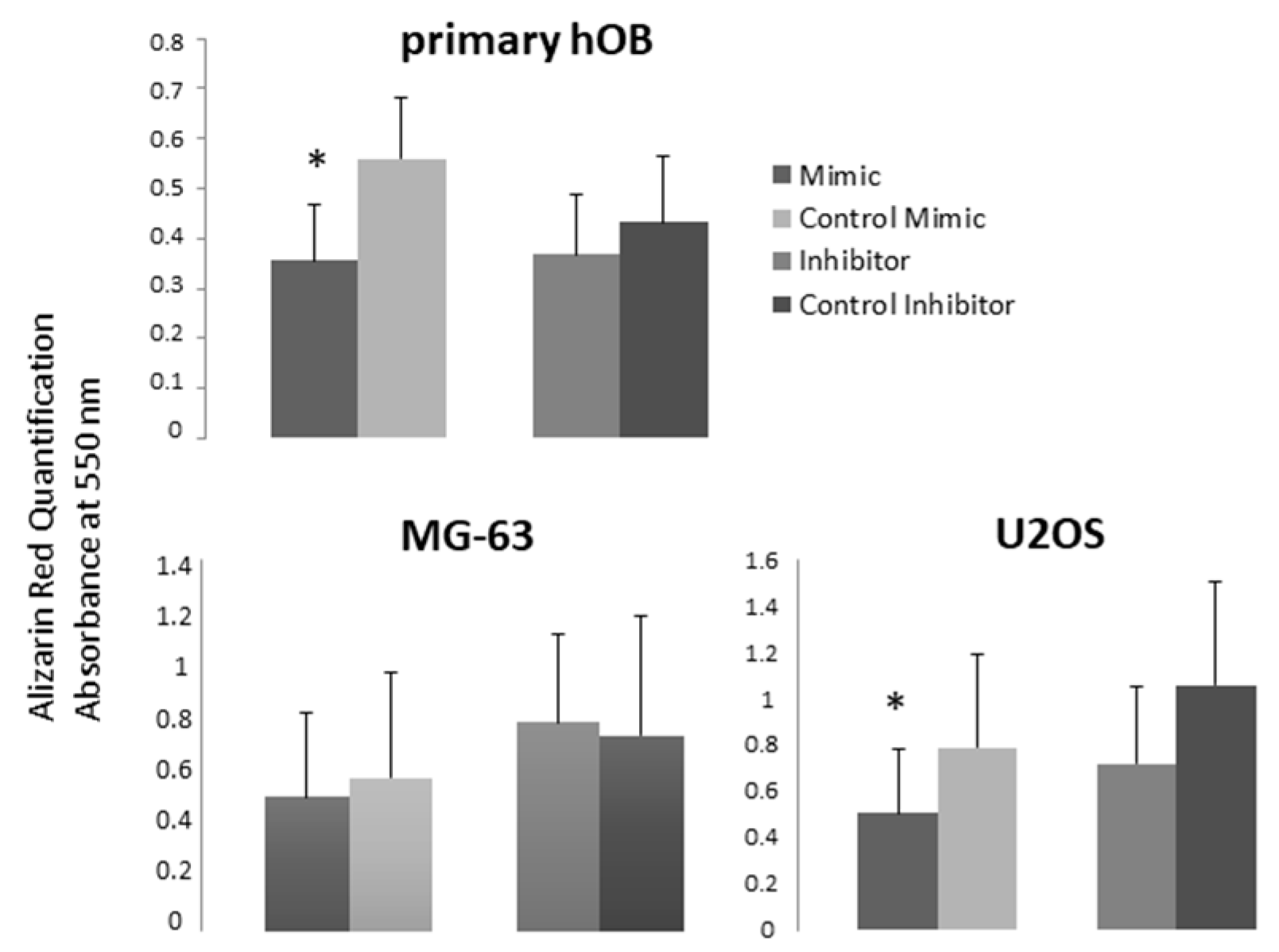
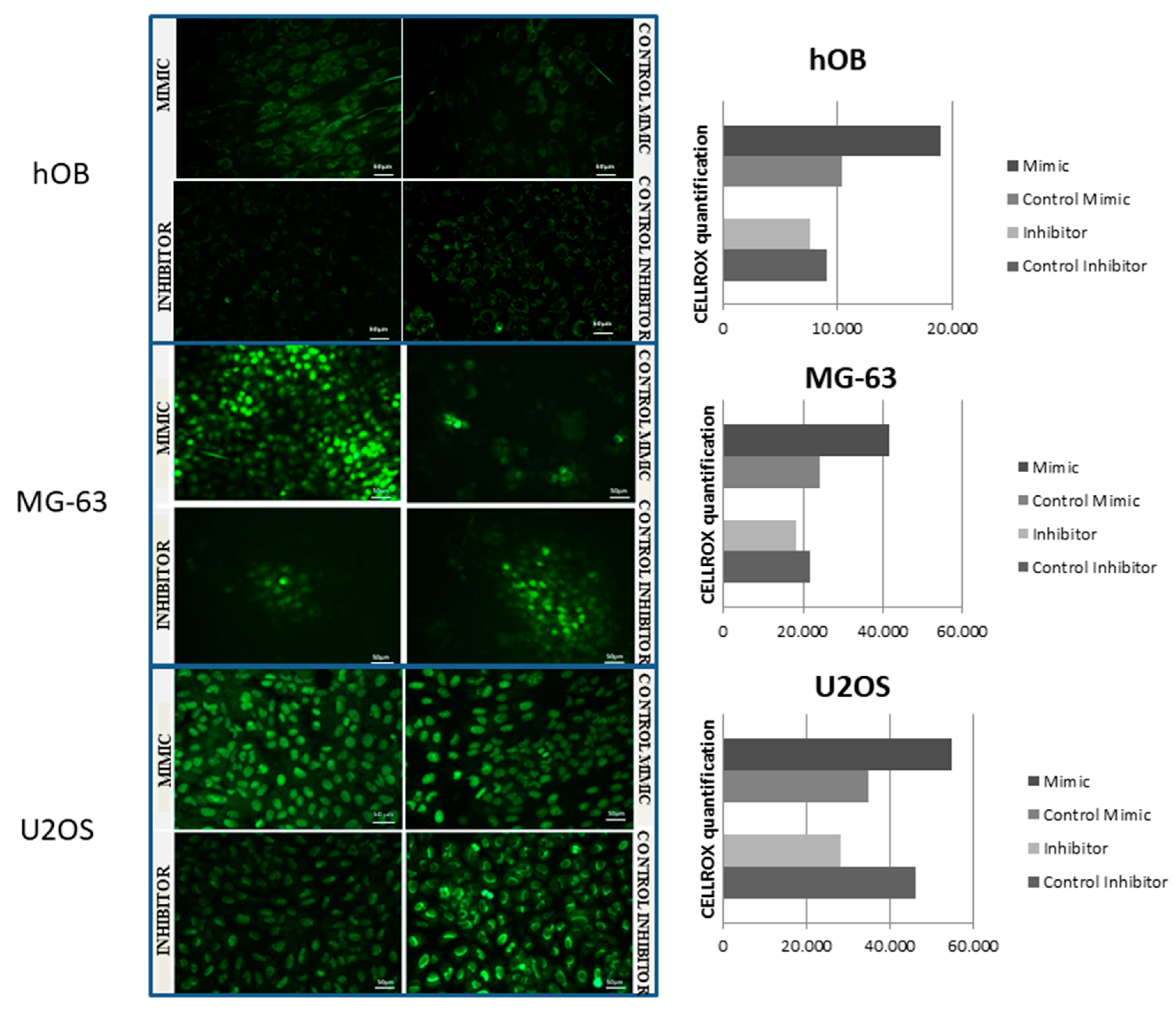
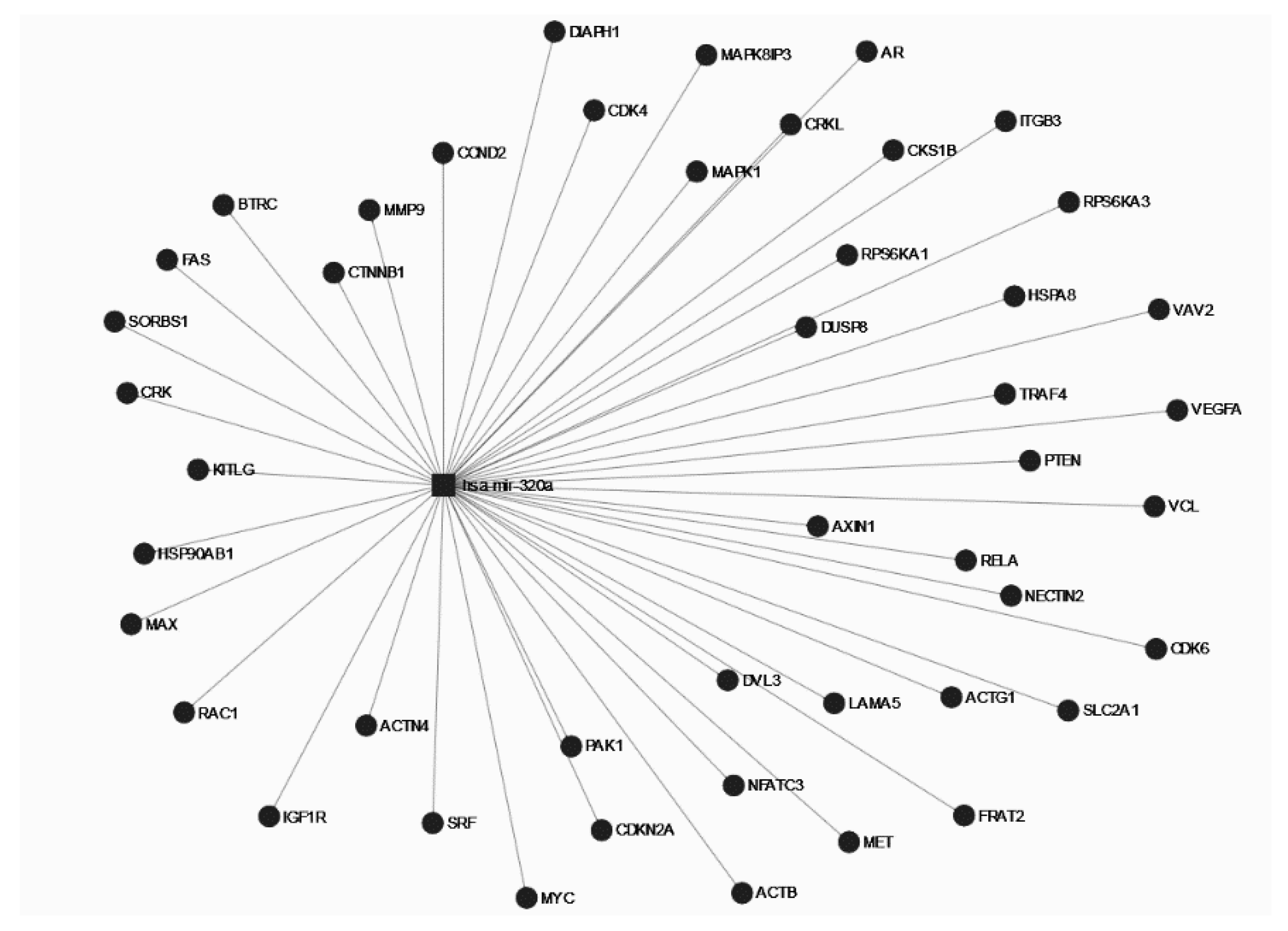
© 2020 by the authors. Licensee MDPI, Basel, Switzerland. This article is an open access article distributed under the terms and conditions of the Creative Commons Attribution (CC BY) license (http://creativecommons.org/licenses/by/4.0/).
Share and Cite
De-Ugarte, L.; Balcells, S.; Guerri-Fernandez, R.; Grinberg, D.; Diez-Perez, A.; Nogues, X.; Garcia-Giralt, N. Effect of the Tumor Suppressor miR-320a on Viability and Functionality of Human Osteosarcoma Cell Lines Compared to Primary Osteoblasts. Appl. Sci. 2020, 10, 2852. https://doi.org/10.3390/app10082852
De-Ugarte L, Balcells S, Guerri-Fernandez R, Grinberg D, Diez-Perez A, Nogues X, Garcia-Giralt N. Effect of the Tumor Suppressor miR-320a on Viability and Functionality of Human Osteosarcoma Cell Lines Compared to Primary Osteoblasts. Applied Sciences. 2020; 10(8):2852. https://doi.org/10.3390/app10082852
Chicago/Turabian StyleDe-Ugarte, Laura, Susanna Balcells, Robert Guerri-Fernandez, Daniel Grinberg, Adolfo Diez-Perez, Xavier Nogues, and Natalia Garcia-Giralt. 2020. "Effect of the Tumor Suppressor miR-320a on Viability and Functionality of Human Osteosarcoma Cell Lines Compared to Primary Osteoblasts" Applied Sciences 10, no. 8: 2852. https://doi.org/10.3390/app10082852
APA StyleDe-Ugarte, L., Balcells, S., Guerri-Fernandez, R., Grinberg, D., Diez-Perez, A., Nogues, X., & Garcia-Giralt, N. (2020). Effect of the Tumor Suppressor miR-320a on Viability and Functionality of Human Osteosarcoma Cell Lines Compared to Primary Osteoblasts. Applied Sciences, 10(8), 2852. https://doi.org/10.3390/app10082852




